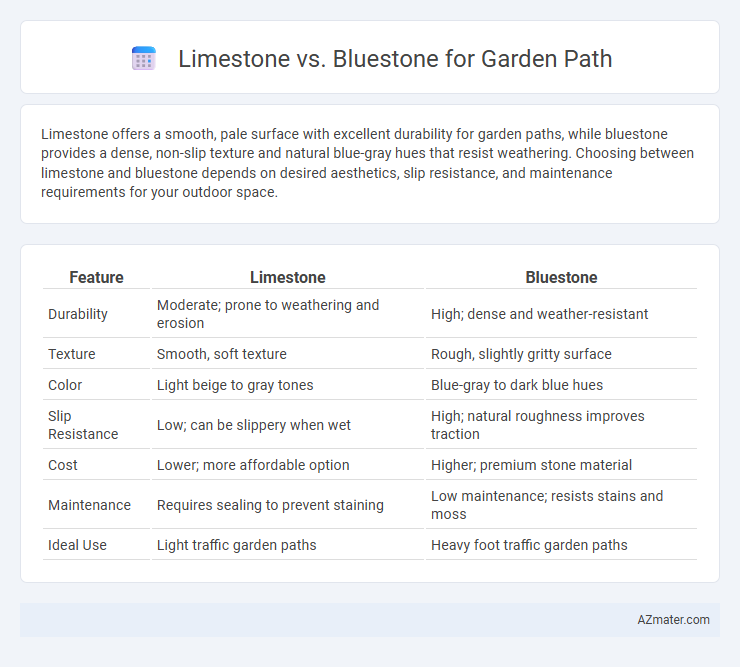Limestone offers a smooth, pale surface with excellent durability for garden paths, while bluestone provides a dense, non-slip texture and natural blue-gray hues that resist weathering. Choosing between limestone and bluestone depends on desired aesthetics, slip resistance, and maintenance requirements for your outdoor space.
Table of Comparison
| Feature | Limestone | Bluestone |
|---|---|---|
| Durability | Moderate; prone to weathering and erosion | High; dense and weather-resistant |
| Texture | Smooth, soft texture | Rough, slightly gritty surface |
| Color | Light beige to gray tones | Blue-gray to dark blue hues |
| Slip Resistance | Low; can be slippery when wet | High; natural roughness improves traction |
| Cost | Lower; more affordable option | Higher; premium stone material |
| Maintenance | Requires sealing to prevent staining | Low maintenance; resists stains and moss |
| Ideal Use | Light traffic garden paths | Heavy foot traffic garden paths |
Introduction: Choosing the Right Stone for Your Garden Path
Limestone and bluestone are popular choices for garden paths due to their durability and aesthetic appeal. Limestone offers a warm, neutral tone with a smooth texture that complements natural landscapes, while bluestone provides a dense, fine-grained surface with a cool blue-gray color ideal for contemporary designs. Selecting the right stone depends on factors such as climate tolerance, slip resistance, and overall garden style to ensure a functional and visually pleasing pathway.
Limestone vs Bluestone: An Overview
Limestone and bluestone are popular choices for garden paths, each offering distinct aesthetic and functional benefits. Limestone typically features a soft, light color palette with a smooth texture, making it ideal for creating elegant, natural-looking walkways that blend seamlessly with greenery. Bluestone, characterized by its dense, durable composition and deep blue-gray hues, is favored for its slip resistance and ability to withstand harsh weather, providing a sturdy and visually striking garden path surface.
Appearance and Color Variations
Limestone for garden paths offers a soft, neutral palette with shades ranging from creamy whites to subtle grays, providing a timeless and elegant look. Bluestone displays a broader spectrum of colors including deep blues, rich grays, and occasionally reddish hues, creating a more dynamic and striking visual impact. The choice between limestone and bluestone hinges on the desired aesthetic, with limestone favoring understated sophistication and bluestone delivering vibrant, textured appeal.
Durability and Weather Resistance
Limestone offers moderate durability with a softer texture that may show wear and weathering over time, making it suitable for low-traffic garden paths. Bluestone is highly durable and weather-resistant, retaining its structural integrity and color even under harsh climates and heavy foot traffic. For long-lasting garden paths exposed to varying weather conditions, bluestone provides superior performance and minimal maintenance.
Texture and Slip Resistance
Limestone offers a smooth, fine-grained texture with moderate slip resistance, making it comfortable underfoot but potentially slippery when wet. Bluestone features a naturally cleft, rough surface providing excellent traction and superior slip resistance, ideal for safe garden paths. Choosing between the two depends on the desired balance of aesthetics and safety, with bluestone favored for high-traffic, moisture-prone areas.
Installation and Workability
Limestone offers easier installation and superior workability for garden paths due to its softer texture, allowing for smooth cutting and shaping to fit various design layouts. Bluestone, being denser and harder, requires specialized tools and more effort during installation but provides greater durability and resistance to wear. Both materials demand proper base preparation and leveling, yet limestone's malleability often results in a faster, less labor-intensive installation process.
Maintenance Requirements
Limestone garden paths require regular sealing and cleaning to prevent staining and erosion caused by weather and foot traffic. Bluestone offers greater durability and lower maintenance, as it resists chipping and does not need frequent sealing, making it ideal for high-traffic garden areas. Both materials benefit from occasional sweeping and washing to maintain their appearance and longevity.
Cost Comparison
Limestone typically costs between $2 to $5 per square foot, making it a more budget-friendly option for garden paths compared to bluestone, which ranges from $5 to $10 per square foot due to its durability and aesthetic appeal. Installation expenses for limestone are generally lower, as it requires less preparation and specialized labor than bluestone. Choosing between limestone and bluestone depends on balancing initial material costs against long-term maintenance and desired visual impact.
Environmental Impact and Sustainability
Limestone and bluestone differ significantly in environmental impact and sustainability for garden paths, with limestone being a sedimentary rock that often requires less energy-intensive quarrying but may contribute to habitat disruption. Bluestone, a type of sandstone, generally involves more extensive mining processes which can lead to increased carbon emissions and ecological disturbance. Sustainable garden path choices prioritize locally sourced materials and reclaimed stone to minimize transportation footprints and reduce the overall environmental impact.
Which Stone Is Best for Your Garden Path?
Limestone offers a soft, light color palette and smooth texture, making it ideal for creating elegant, formal garden paths with good durability and ease of maintenance. Bluestone provides a rich, deep blue-gray color and natural cleft surface, delivering excellent slip resistance and a rustic, natural look suited for informal or woodland garden paths. Choosing the best stone depends on your desired aesthetic, slip resistance needs, and climate considerations, with limestone preferred for polished appearances and bluestone favored for rugged, natural pathways.

Infographic: Limestone vs Bluestone for Garden Path
 azmater.com
azmater.com